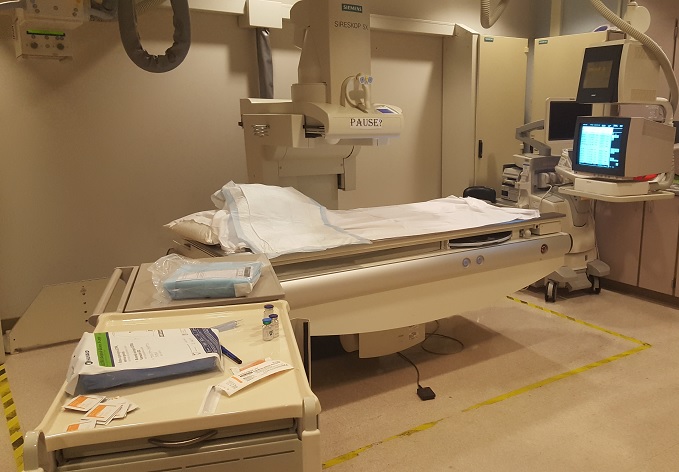Please be advised:
Joint Arthrograms and Joint Steroid Injections are done by appointment only, and only in Ambulatory Care Center. For directions please click here. For appointment questions, please click here.
What is a Joint Arthrogram?
Arthrography is medical imaging to evaluate conditions of joints.
With direct arthrography the contrast material is injected directly into the joint by a radiologist. Direct arthrography is preferred over indirect arthrography because it distends or enlarges the joint thus allowing for enhanced imaging of small internal structures. This leads to improved evaluation of diseases or conditions within the joint. It is often performed only if a non-arthrographic exam is felt to be inadequate in assessing a joint abnormality.
What is a Joint Steroid Injection?
The medication injected into the joint can be a local anesthetic, such as lidocaine or bupivacaine, and may also include an anti-inflammatory medication, such as a corticosteroid. If the local anesthetic provides immediate pain relief. As an example, it diagnoses the sacroiliac joint as the source of the patient's pain.
Before my Arthrogram or Steroid Injection appointment
How do I prepare for my Arthrogram exam?
- You will be asked to arrive 20 minutes prior to your appointment
- If arthrogram will be followed by MRI, you will be asked to fill out the MRI Safety From. Click Here to view the form.
- You will be asked to change into a hospital gown and lock up your belongings.
- You will meet with the doctors before your exam.
- Bring a list of all medicines that you are taking.
- Prepare any questions you might have and ask them at this time.
- You must give written consent before your arthrogram can begin.
- Arthrogram CT, Arthrogram MRI and Arthrogram exams are done only in ACC (Ambulatory Care Center). Click here for directions.
What will happen during my Arthrogram exam?
- Your skin will be cleaned with an antiseptic soap.
- The radiologist will then use a needle to numb the area with a local anesthetic (a numbing medicine).
- When the area is numb, a needle will be placed into your joint space. A fluoroscope will be used to guide the needle.
- When the needle is in the correct place, contrast will be injected. Your joint may feel “full,” or you may feel some pressure in the joint.
- X-ray images will then be taken.
- The arthrogram will take about 30 minutes.
- If arthrogram will be followed by CT or MRI, you will be sent to the CT or MRI room for part 2 of the study.

After my Arthrogram or Steroid Injection appointment
Dos and Don’ts in the days following the procedure:
- Keep the site of injection dry and clean for 24 hours.
- Avoid strenuous exercise for 24 hours.
- Avoid movements that worsen pain.
- If you received steroid injection, maintain a pain dairy.
What to expect following the procedure:
- The local anesthetic generally takes effect immediately and will last for a few hours.
- The steroid generally takes between two to seven days to take effect, so you may experience a period before the steroid takes effect where you have no relief, and it may be necessary to take some pain relief medications during this time.
- Some patients may experience a short period of post-injection “flare” of pain and local swelling after a steroid injection. This may occur within first 24-36 hours.
- The day after the steroid injection, some patients experience a short-term side effect of facial flushing with a warm sensation.
- If you have diabetes, you may experience a rise in your blood sugar level for a few days after receiving a steroid injection. Please monitor these levels carefully and seek advice from your physician if concerned.
If you experience pain or discomfort in the affected area:
- Apply a cold compress to the affected area.
- If allowed by your physician, take an over-the-counter anti-inflammatory medication like ibuprofen (Motrin or Advil), or Acetaminophen (Tylenol).
Please call your referring physician if you notice:
- Persistent or increasing pain and redness at the site of injection.
- Fever and chills.
- Decreased range of motion of the joint that was injected.
For your results please consult your Primary Care Physician or check MyChart.
We thank you for choosing UC Davis Health Radiology for your medical imaging.

